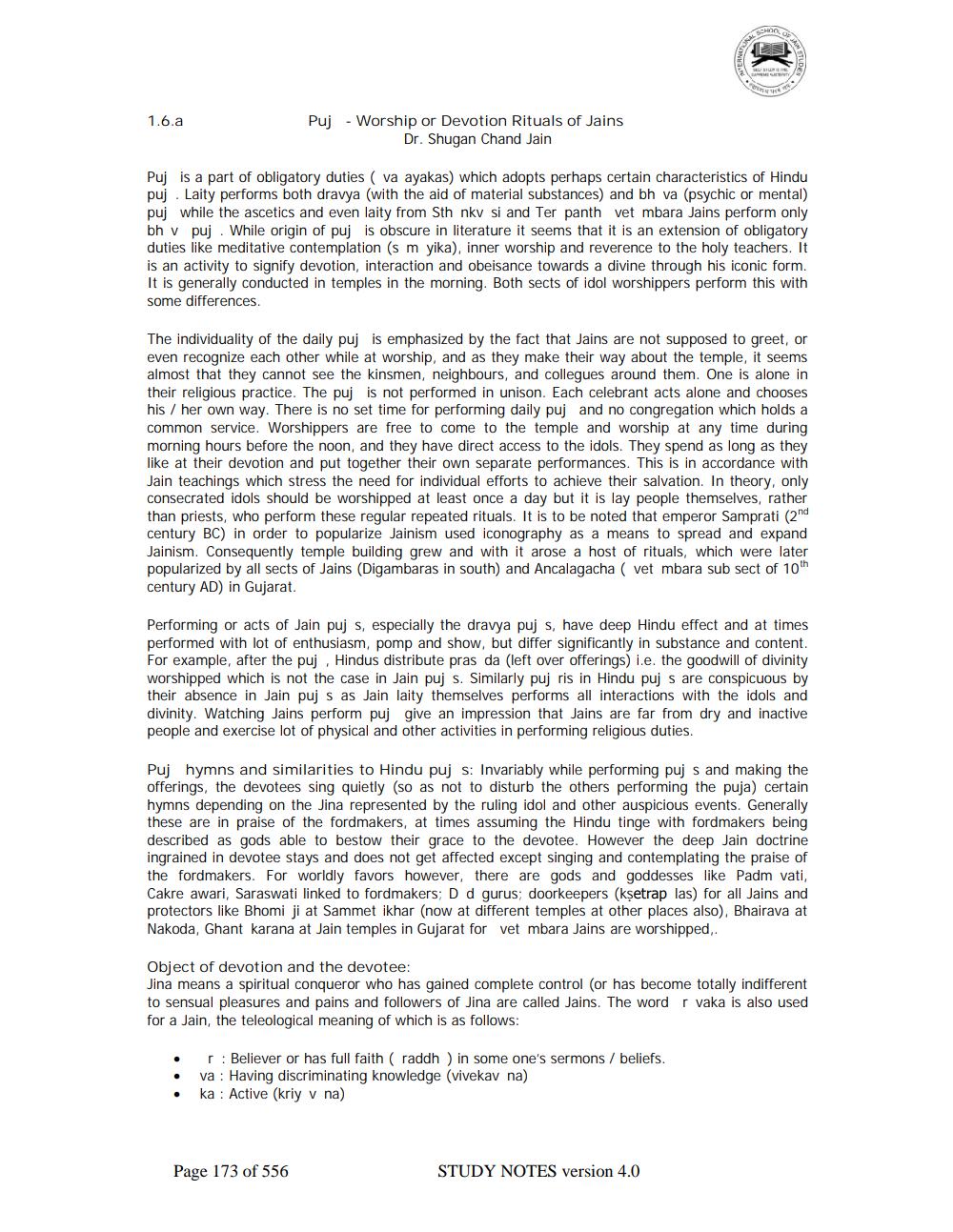________________
1.6.a
Puj - Worship or Devotion Rituals of Jains
Dr. Shugan Chand Jain
Puj is a part of obligatory duties ( va ayakas) which adopts perhaps certain characteristics of Hindu puj . Laity performs both dravya (with the aid of material substances) and bh va (psychic or mental) puj while the ascetics and even laity from Sth nkv si and Ter panth vet mbara Jains perform only bh v puj. While origin of puj is obscure in literature it seems that it is an extension of obligatory duties like meditative contemplation (s m yika), inner worship and reverence to the holy teachers. It is an activity to signify devotion, interaction and obeisance towards a divine through his iconic form. It is generally conducted in temples in the morning. Both sects of idol worshippers perform this with some differences.
The individuality of the daily puj is emphasized by the fact that Jains are not supposed to greet, or even recognize each other while at worship, and as they make their way about the temple, it seems almost that they cannot see the kinsmen, neighbours, and collegues around them. One is alone in their religious practice. The puj is not performed in unison. Each celebrant acts alone and chooses his / her own way. There is no set time for performing daily puj and no congregation which holds a common service. Worshippers are free to come to the temple and worship at any time during morning hours before the noon, and they have direct access to the idols. They spend as long as they like at their devotion and put together their own separate performances. This is in accordance with Jain teachings which stress the need for individual efforts to achieve their salvation. In theory, only consecrated idols should be worshipped at least once a day but it is lay people themselves, rather than priests, who perform these regular repeated rituals. It is to be noted that emperor Samprati (2nd century BC) in order to popularize Jainism used iconography as a means to spread and expand Jainism. Consequently temple building grew and with it arose a host of rituals, which were later popularized by all sects of Jains (Digambaras in south) and Ancalagacha ( vet mbara sub sect of 10th century AD) in Gujarat.
Performing or acts of Jain puj s, especially the dravya puj s, have deep Hindu effect and at times performed with lot of enthusiasm, pomp and show, but differ significantly in substance and content. For example, after the puj, Hindus distribute pras da (left over offerings) i.e. the goodwill of divinity worshipped which is not the case in Jain puj s. Similarly puj ris in Hindu puj s are conspicuous by their absence in Jain puj s as Jain laity themselves performs all interactions with the idols and divinity. Watching Jains perform puj give an impression that Jains are far from dry and inactive people and exercise lot of physical and other activities in performing religious duties.
Puj hymns and similarities to Hindu puj s: Invariably while performing puj s and making the offerings, the devotees sing quietly (so as not to disturb the others performing the puja) certain hymns depending on the Jina represented by the ruling idol and other auspicious events. Generally these are in praise of the fordmakers, at times assuming the Hindu tinge with fordmakers being described as gods able to bestow their grace to the devotee. However the deep Jain doctrine ingrained in devotee stays and does not get affected except singing and contemplating the praise of the fordmakers. For worldly favors however, there are gods and goddesses like Padm vati, Cakre awari, Saraswati linked to fordmakers; Dd gurus; doorkeepers (ksetrap las) for all Jains and protectors like Bhomi ji at Sammet ikhar (now at different temples at other places also), Bhairava at Nakoda, Ghant karana at Jain temples in Gujarat for vet mbara Jains are worshipped,
Object of devotion and the devotee: Jina means a spiritual conqueror who has gained complete control (or has become totally indifferent to sensual pleasures and pains and followers of Jina are called Jains. The word r vaka is also used for a Jain, the teleological meaning of which is as follows:
• • •
: Believer or has full faith (raddh) in some one's sermons / beliefs. va : Having discriminating knowledge (vivekav na) ka: Active (kriy v na)
Page 173 of 556
STUDY NOTES version 4.0




